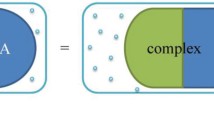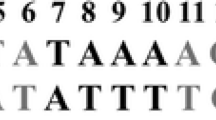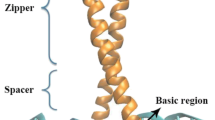Abstract
Proline-rich homeodomain (PRH) is a regulatory protein controlling transcription and gene expression processes by binding to the specific sequence of DNA, especially to the sequence 5′-TAATNN-3′. The impact of base pair mutations on the binding between the PRH protein and DNA is investigated using molecular dynamics and free energy simulations to identify DNA sequences that form stable complexes with PRH. Three 20-ns molecular dynamics simulations (PRH–TAATTG, PRH–TAATTA and PRH–TAATGG complexes) in explicit solvent water were performed to investigate three complexes structurally. Structural analysis shows that the native TAATTG sequence forms a complex that is more stable than complexes with base pair mutations. It is also observed that upon mutation, the number and occupancy of the direct and water-mediated hydrogen bonds decrease. Free energy calculations performed with the thermodynamic integration method predict relative binding free energies of 0.64 and 2 kcal/mol for GC to AT and TA to GC mutations, respectively, suggesting that among the three DNA sequences, the PRH–TAATTG complex is more stable than the two mutated complexes. In addition, it is demonstrated that the stability of the PRH–TAATTA complex is greater than that of the PRH–TAATGG complex.











Similar content being viewed by others
References
Beierlein FR, Kneale GG, Clark T (2011) Predicting the effects of basepair mutations in DNA-protein complexes by thermodynamic integration. Biophys J 101:1130–1138
Beveridge DL, Dicapua FM (1989) Free-energy via molecular simulation—applications to chemical and biomolecular systems. Annu Rev Biophys Biophys Chem 18:431–492
Billeter M (1996) Homeodomain-type DNA recognition. Prog Biophys Mol Biol 66:211–225
Boresch S, Tettinger F, Leitgeb M, Karplus M (2003) Absolute binding free energies: a quantitative approach for their calculation. J Phys Chem B 107:9535–9551
Case DA, Darden TA, Kollman PA (2008) AMBER 10. University of California, San Francisco, CA
Crompton MR, Bartlett TJ, MacGregor AD, Manfioletti G, Buratti E, Giancotti V, Goodwin GH (1992) Identification of a novel vertebrate homeobox gene expressed in haematopoietic cells. Nucleic Acids Res 20:5661–5667
Deng YQ, Roux B (2009) Computations of standard binding free energies with molecular dynamics simulations. J Phys Chem B 113:2234–2246
Duan J, Nilsson L (2002) The role of residue 50 and hydration water molecules in homeodomain DNA recognition. Eur Biophys J 31:306–316
Duan Y, Wu C, Chowdhury S, Lee MC, Xiong G, Zhang W, Yang R, Cieplak P, Luo R, Lee T, Caldwell J, Wang J, Kollman P (2003) A point-charge force field for molecular mechanics simulations of proteins based on condensed-phase quantum mechanical calculations. J Comput Chem 24:1999–2012
Essman U, Perela L, Berkowitz ML, Darden T, Lee H, Pedersen LG (1995) A smooth particle mesh Ewald method. J Chem Phys 103:8577–8593
Foley AC, Mercola M (2005) Heart induction by Wnt antagonists depends on the homeodomain transcription factor Hex. Gene Dev 19:387–396
Fraenkel E, Rould MA, Chamber KA, Pabo CO (1998) Engrailed homeodomain–DNA complex at 2.2 Å resolution: a detailed view of the interface and comparison with other engrailed structures. J Mol Biol 284:351–361
Gao J, Kuczera K, Karplus M (1989) Hidden thermodynamics of mutant proteins: a molecular dynamics analysis. Science 244:1069–1072
Gille C (2006) Structural interpretation of mutations and SNPs using STRAP-NT. Protein Sci 15:208–210
Gilson MK, Given JA, Bush BL, McCammon JA (1997) The statistical-thermodynamic basis for computation of binding affinities: a critical review. Biophys J 72:1047–1069
Guiral M, Bess K, Goodwin G, Jayaraman PS (2001) PRH represses transcription in hematopoietic cells by at least two independent mechanisms. J Biol Chem 276:2961–2970
Guo Y, Chan R, Ramsey H, Li W, Xie X, Shelley WC, Martinez-Barbera JP, Bort B, Zaret K, Yoder M (2003) The homeoprotein Hex is required for hemangioblast differentiation. Blood 102:2428–2435
Hanes SD, Brent R (1991) A genetic model for interaction of the homeodomain recognition helix with DNA. Science 251:426–430
Hart K, Nilsson L (2008) Investigation of transcription factor Ndt80 affinity differences for wild type and mutant DNA: a molecular dynamics study. Proteins 73:325–337
Hess B (2002) Determining the shear viscosity of model liquids from molecular dynamics simulations. J Chem Phys 116:209–217
Hockney RW (1970) The potential calculation and some applications. Methods Comput Phys 9:135–211
Hoover WG (1985) Canonical dynamics: equilibrium phase-space distributions. Phys Rev A 31:1695–1697
Hovde S, Abate-Shen C, Geiger JH (2001) Crystal structure of the Msx-1 homeodomain/DNA complex. Biochemistry 40:12013–12021
HyperChem (TM) (2002) Hypercube, Inc., 1115 NW 4th Street, Gainesville, Florida 32601, USA
Jalili S, Karami L (2012) Study of intermolecular contacts in the proline-rich homeodomain (PRH)–DNA complex using molecular dynamics simulations. Eur Biophys J 41:329–340
Jayaraman PS, Frampton J, Goodwin G (2000) The homeodomain protein PRH influences the differentiation of haematopoietic cells. Leukemia Res 24:1023–1031
Jorgensen WL, Charndrasekhar J, Madura JD, Impey RW, Klein ML (1983) Comparison of simple potential functions for simulating liquid water. J Chem Phys 79:926–935
Kabsch W, Sander C (1983) Dictionary of protein secondary structure: pattern-recognition of hydrogen-bonded and geometrical features. Biopolymers 22:2577–2637
Kasamatsu S, Sato A, Yamamoto T, Keng VW, Yoshida H, Yamazaki Y (2004) Identification of the transactivating region of the homeodomain protein, hex. J Biochem 135:217–223
Kirkwood JG (1935) Statistical mechanics of fluid mixtures. J Chem Phys 3:300–313
Kissinger CR, Liu BS, Martin-Blanco E, Kornberg TB, Pabo CO (1990) Crystal structure of an engrailed homeodomain–DNA complex at 2.8 Å resolution: a framework for understanding homeodomain–DNA interactions. Cell 63:579–590
Kollman P (1993) Free-energy calculations—applications to chemical and biochemical phenomena. Chem Rev 93:2395–2417
Kwok JBJ, Li Q-X, Hallupp M, Whyte S, Ames D, Beyreuther K, Masters CL, Schofield PR (2000) Novel Leu723Pro amyloid precursor protein mutation increases amyloid β42(43) peptide levels and induces apoptosis. Ann Neurol 47:249–253
Laughon A (1991) DNA binding specificity of homeodomains. Biochemistry 30:11357–11367
Loken C et al (2010) SciNet: Lessons learned from building a power-efficient top-20 system and data centre. J Phys Conf Ser 256:012026
Martinez-Barbera JP, Clements M, Thomas P, Rodriguez T, Meloy D, Kioussis D, Beddington RS (2000) The homeobox gene Hex is required in definitive endodermal tissues for normal forebrain, liver and thyroid formation. Development 127:2433–2445
Nosé S (1984) A unified formulation of the constant temperature molecular dynamics methods. J Chem Phys 81:511–519
Parrinello M, Rahman A (1981) Polymorphic transitions in single crystals: a new molecular dynamics method. J Appl Phys 52:7182–7190
Pellizzari L, D’Elia A, Rustighi A, Manfioletti G, Tell G, Damante G (2000) Expression and function of the homeodomain-containing protein Hex in thyroid cells. Nucleic Acids Res 28:2503–2511
Pérez A, Marcha’n I, Orozco M (2007) Refinement of the AMBER force field for nucleic acids: improving the description of α/γ conformers. Biophys J 92:3817–3829
Qian YQ, Billeter M, Otting G, Müller M, Gehring WJ, Wüthrich K (1989) The structure of the Antennapedia homeodomain determined by NMR spectroscopy in solution: comparison with prokaryotic repressors. Cell 59:573–580
Reyes CM, Kollman PA (1999) Molecular dynamics study of U1A-RNA complexes. RNA 5:235–244
Ryckaert JP, Ciccotti G, Berendsen HJC (1977) Numerical integration of the cartesian equations of motion of a system with constraints: molecular dynamics of n-Alkanes. J Comput Phys 23:327–341
Schier AF, Gehring WJ (1993) Functional specificity of the homeodomain protein fushi tarazu: the role of DNA-binding specificity in vivo. Proc Natl Acad Sci USA 90:1450–1454
Sen S, Nilsson L (1999) Structure, interaction, dynamics and solvent effects on the DNA-EcoRI complex in aqueous solution from molecular dynamics simulation. Biophys J 77:1782–1800
Simonson T, Archontis G, Karplus M (2002) Free energy simulations come of age: protein-ligand recognition. Acc Chem Res 35:430–437
Sneddon SF, Tobias DJ, Brooks CL (1989) Thermodynamics of amide hydrogen-bond formation in polar and apolar solvents. J Mol Biol 209:817–820
Steinbrecher T, Mobley DL, Case DA (2007) Nonlinear scaling schemes for Lennard-Jones interactions in free energy calculations. J Chem Phys 127:214108–214121
Swingler TE, Bess KL, Yao J, Stifani S, Jayaraman PS (2004) The proline-rich homeodomain protein recruits members of the Groucho/Transducin-like enhancer of split protein family to co-repress transcription in hematopoietic cells. J Biol Chem 279:34938–34947
Tsui V, Radhakrishnan I, Wright PE, Case DA (2000) NMR and molecular dynamics studies of hydration of a zinc finger-DNA complex. J Mol Biol 302:1101–1117
Tutorial 9, AMBER web site (2009) http://ambermd.org/tutorials/advanced/tutorial9/
van der Spoel D, Lindahl E, Hess B, Groenhof G, Mark AE, Berendsen HJC (2005) GROMACS: fast, flexible and free. J Comput Chem 26:1701–1718
Zwanzig RW (1954) High-temperature equation of state by a perturbation method. I. Nonpolar gases. J Chem Phys 22:1420–1426
Acknowledgments
Computations were performed on the gpc supercomputer at the SciNet (Loken et al. 2010) HPC Consortium. SciNet is funded by: the Canada Foundation for Innovation under the auspices of Compute Canada; the Government of Ontario; Ontario Research Fund—Research Excellence; and the University of Toronto.
Author information
Authors and Affiliations
Corresponding author
Rights and permissions
About this article
Cite this article
Jalili, S., Karami, L. & Schofield, J. Study of base pair mutations in proline-rich homeodomain (PRH)–DNA complexes using molecular dynamics. Eur Biophys J 42, 427–440 (2013). https://doi.org/10.1007/s00249-013-0892-2
Received:
Revised:
Accepted:
Published:
Issue Date:
DOI: https://doi.org/10.1007/s00249-013-0892-2




